Updated 04/10/2004
OK, by now almost everyone knows what a recumbent is; but for those who still haven’t gotten the word:
OK, by now almost everyone knows what a recumbent is; but for those who still haven’t gotten the word:
| A recumbent is a bicycle in which the rider sits in a chair-like seat with feet to the front, instead of perching on a saddle and leaning forward. From the French word meaning, “lying down,” the term ‘recumbent’ is more a description of the riding position than an actual label. They are also variously named liegerads (lying-down bikes,) horizontals, or simply ‘bents. So, on to the questions… |
| Q. Why would someone
want to ride one in the first place? A. In a word, comfort. The rider sits in a chair-like seat, with no weight being borne by the hands. The back is supported and the head is naturally upright. The entire concept of the recumbent revolves around the concept that sitting reclined is ergonomically superior to perching on a traditional safety bicycle. |
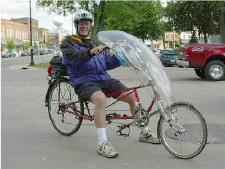 |
| Q. How long have recumbents been around?
A. Would you believe they've been around as long as safety bikes? When chains became economically viable due to mass production, it opened up the design possibilities for bicycles. In the 'golden age' of bicycles (pre-automobile,) bicycles existed in amazing variety, including models we would recognize today as recumbents. As you can see by the date to the right, this recumbent was on the road before Henry Ford's (and others') products started dominating the scene. |
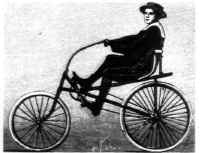 Challand "Horizontal Bicyclette normale" Picture from "La Nature" October 1896. |
| Q.
Why is it I only see fat old guys with beards riding recumbents? A. I can't explain the beard, either. In the United States, recumbents are becoming popular with baby-boomers, and especially among the male segment of the population. The stereotypical examples are returning to exercise, often after a hiatus of 20 years or more. With age, they say, comes wisdom. They discover that:
|
| Q. If they’re that much more comfortable,
why doesn’t everybody ride them? A. There are lots of opinions, but it’s generally agreed that a large factor was the 1934 ruling by the UCI that disallowed recumbents from racing. The UCI sought to standardize bicycle design so that the major difference between competitors was the athlete, not the equipment. A second-rate cyclist riding a recumbent had started winning all his races, even breaking the prestigious world record for an hour, and it was decided that recumbents represented an unfair advantage. Had the ruling taken place a few decades prior, we might all be riding around on Penny-Farthings now; but as it is, the design they standardized was the ‘Safety Bicycle,’ so named because its two equal-sized tires made it safer to ride than the older high-wheel design. No major manufacturer wanted to produce bicycles that didn’t fit the UCI definition, and so other designs, among them recumbents, languished. |
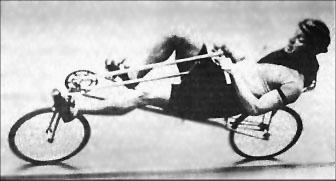
hour record in 1933 Photo from "Human Power" Vol 11 No 3 |
| Q. So, are recumbents bicycles?
A. Due to the UCI ruling, it is a common misconception that a recumbent somehow isn’t a ‘real’ bike. It is, it just doesn’t fall within the UCI rules. Effective in 2004, the USCF has defined recumbents as a class. More on that below. |
| Q. I’ve never seen recumbents race, even
at USCF events. If they’re legal, why not? A. Under the old pre-2004 rules, a bicycle of any type was considered legal as long as it fit within the defined dimensions: less than 2 meters long and less than 74 cm wide. Despite this, and with nothing in the rule book to support them, most race directors barred them. Under the new rules, recumbents are a separate class and may not race unless a separate category is provided for them. Race organizers are not required to offer a recumbent category, though. The unofficial ban has effectively become official. Happily, there are other venues for those wishing to race recumbents. The HPRA, or Human Powered Racing Association, hosts a series of races around the Great Lakes every year, and in fact the popularity is spreading to other areas of the country, too. Although safety bicycles are allowed too, the major competitors in these races are recumbents. |
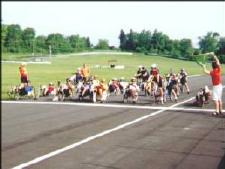 See the lone safety bike toward the right? |
| Q. Are recumbents really faster?
A. The answer to that is a definite ‘maybe.’ Some recumbents are designed for speed and are blazingly fast. Others are not. Generally, speed is achieved by either adding aerodynamic panels called ‘fairings’ or by severely reclining the rider in order to decrease the frontal area of the bike/rider combination. And, don’t forget, aerodynamics don’t mean anything unless the rider is strong enough to propel the bike to speeds where aerodynamics are a significant factor. The bottom line is recumbents don’t automatically make everyone faster. |
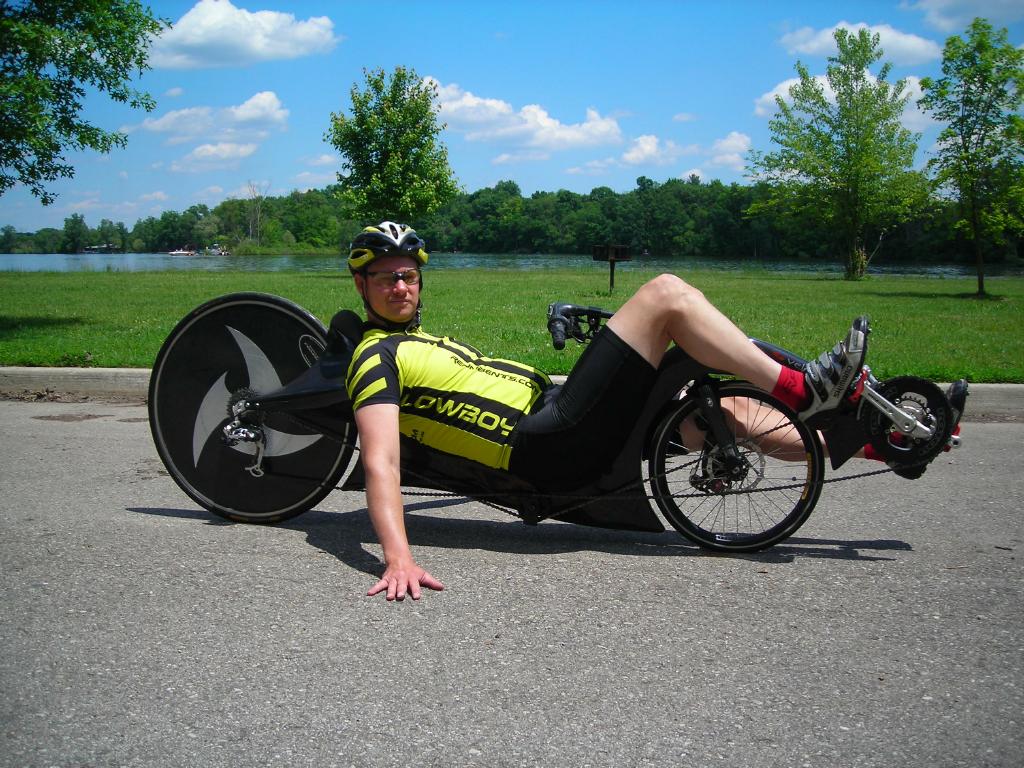 |
| Q. You hint at different types. What types of recumbents are
there? A. There are three major categories, defined by their wheelbases: Short wheelbase, medium wheelbase, and long wheelbase. Short wheelbase bikes, or SWBs, have the pedals out in front of the front wheel, while long wheelbase bikes (LWBs) have the pedals behind the front wheel. Medium wheelbase bikes (MWB) generally have the pedals above or just behind the front wheel, but shorten the bike by bringing the back wheel under the rider. Bikes in any category may have steering over or under the seat, shortened as OSS or USS. Lowracers and highracers are variants of the short wheelbase category, and offer extremely laid back rider positioning for the sake of speed. |
 |
| Q. Besides rider position, are there
other factors that make a recumbent fast? A. Yes. The following are points to look for when looking for a fast recumbent:
|
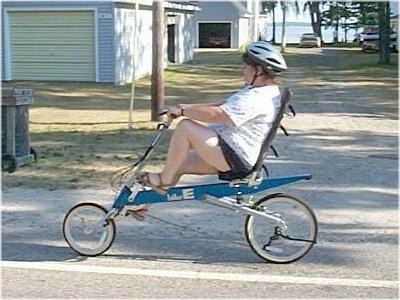 MWB recumbents are usually made for ease of learning, not speed. Note the upright seating position.
|
| Q. Why do most of them have a small front
wheel? A. For short wheelbase bikes, a small wheel makes the stretch for the pedals more manageable, and keeps the boom shorter for less frame flex. In a long wheelbase configuration, it helps keep the wheelbase from becoming unmanageably long, by allowing the front axle to be pulled in closer to the pedals. For any style recumbent, a small front wheel allows the headset to be lower; and since the rider must be able to see over the headset, it allows the rider to be positioned lower for better aerodynamics. |
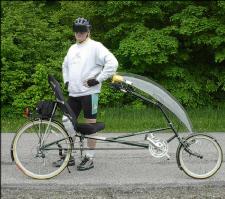 |
| Q. I’ve heard that they don’t do hills…
A. This is a huge generalization, but in many cases, recumbents are slower than safety bicycles when climbing. Differences vary widely depending on the rider, the hill, and the recumbent in question. The usual reasons given are that they are heavier and the riders cannot stand on the pedals. But never fear; the recumbent rider can conquer any hill that’s doable on an upright, even though it may be at a slower speed. For this reason, most recumbents come with triple chainrings to get low enough gears. Another note on hills… As shown here, sometimes recumbents have an advantage even on steep climbs! |
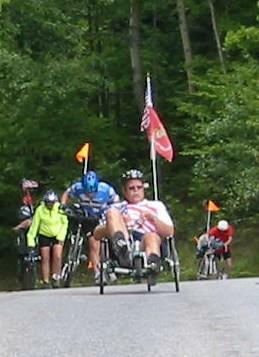 DALMAC 2003 photo by T. Woodward |
| Q. I can understand that a rider can’t
stand while pedaling, but why are they heavier? A. Several reasons. First, they have three times the chain as a safety bike. Also there’s that comfy but necessarily heavier seat. And of course, the seat is mounted on a horizontal tube, necessitating thicker walled tubing to avoid kinking the tubing. |
| Q. Can they be ridden offroad?
A. Although some models can do relatively easy offroad stuff like paths and fire trails, recumbents cannot do technical stuff like jump logs, track stand, and lift wheels one at a time. Regardless of suspension, ‘getting air’ is not recommended due to the possibility of spinal compression injuries if the shocks bottom out. |
| Q. I’d be worried about being low. Can
they be seen? A. Except for the lowracer variety, most recumbents place the rider at about the same height as an automobile driver’s head. Most recumbent riders claim that they feel safer and more visible on a recumbent. This may be the result of recumbents looking ‘different,’ or it may be that a recumbent rider's moving feet are more visible. Whatever it is, drivers seem to notice them in spite of lower overall height. Lowracers probably aren't a good choice for heavy traffic, but even they are easily seen out on the open road. |
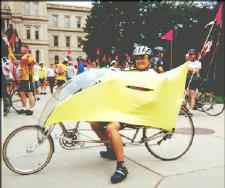
|
| Q. Where are recumbents sold?
A. Some models are sold direct by the manufacturer, others are sold by bike shops. Recumbents are usually special order due to their low volume nature. Some bike shops won’t deal with recumbents because they don’t want to deal with something different. If you run into one of them, just go someplace else! |
| Q. If my local dealer doesn’t know much
about recumbents, where can I learn? A. There are several sources. http://www.bentrideronline.com has a Recumbent Buyer’s Guide and several forums. http://www.recumbents.com maintains a Recumbent Database and also has several forums. http://www.ihpva.org/mailman/listinfo/hpv This page is for subscribing to a recumbent-oriented mailing list. I should mention the newsgroup alt.rec.bicycles.recumbent ; but this newsgroup has devolved, and no longer has very much recumbent content. |
| Q. Recumbents seem to cost more than
similarly-equipped safety bicycles. Why? A. The difference in price is getting smaller, but there’s still a financial ‘hit’ to buying a recumbent. Seats and stem/handlebars rely on labor-intensive custom assemblies instead of mass-stamped parts destined for the safety bicycle market. Also, most recumbent manufacturers are small companies, and can’t benefit from volume orders of components. |
| Q. My friend got a sporty model
recumbent, but he was slower on it. A. Your friend probably trained many years on his safety bike to get as fast as he is. Recumbents use slightly different muscle groupings, and so being fast on one platform does not necessarily make someone fast on the other. Most longtime recumbent riders agree that it took them anywhere from a few months to a year or more to become as fast as they previously were on their safety bikes. Your friend should train just as hard on his recumbent as he did on his safety bike if he wants maximum results. Also, if speed is a goal, make sure you get a recumbent that's capable of it. As written above, most sport models do not have a significant speed advantage over safety bicycles. The late, lamented BikeE was notorious for touting the speed advantage of recumbents, in spite of their lineup's pedestrian performance. Do your research and remember that a dealer is usually trying to sell what he already has on the floor, not necessarily what you want. |
![]()